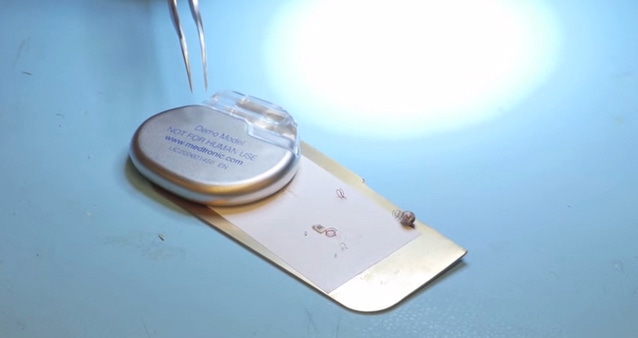Stanford University researchers have discovered a new wavelength of wireless power that could make pacemakers and other implants smaller than they have ever been.
May 22, 2014

Wireless power would enable implants to be many times smaller (right) than their current counterparts (left). Image credit: Stanford University |
If you want to know why any implantable device is as large as it is, you only need to look at the battery. In a new study published in the May issue of Proceedings of the National Academy of Sciences, researchers led by professor Ada Poon, assistant professor of electrical engineering at Stanford University, have discovered a new form of electromagnetic power transfer they are calling “midfield” that could power the world's smallest medical implants.
“Electronics can do remarkable things in the body but we need to make these devices as small as possible in order to implant them easily,” Poon says in an interview from Stanford. The potential of wireless power is to not only make implants smaller but also extend their battery life as well.
While many companies have developed various systems for wireless power, there have always been pros and cons to contend with. Traditionally, electromagnetic power happens over the nearfield range. While this helps avoid harmful interactions with biological tissues it also only allows power transfer over very short distances and not very deep into the body. Farfield waves like the kind used in WiFi or radio can travel long distances but are too weak to penetrate living tissue. The midfield waves discovered by Poon and her colleagues falls right into the sweet spot between these two.
Learn about "Designing Next-Gen Medical Devices" at the MD&M East Conference June 9, 2014. |
For their study the Stanford researchers created a miniature pacemaker device containing a power harvesting coil, integrated circuits, electrodes, and fixation structures – all in a package about the size of a grain of rice (2 mm, 70 mg) and implanted it into a rabbit. Using a flat external structure about the size of a credit card, researchers were able to create electromagnetic waves that penetrated deep (over 5cm) into the body to power the pacemaker.
While the technology is some years away from being commercially available Poon and her team hopes that it will be used to power the next generation of implants for a variety of purposes from cardiac implants to deep brain stimulation devices and beyond. Tiny devices like these could also be placed more precisely (directly onto a nerve bundle for example) and help to minimize the cost and risks associated with large implants.
The researchers detail more about their midfield technology in the video below.
-Chris Wiltz, Associate Editor, MD+DI
[email protected]
You May Also Like


.png?width=300&auto=webp&quality=80&disable=upscale)